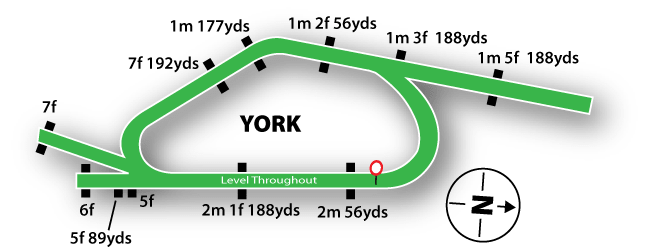YORK Racecourse Tips
Predictions can be updated until 09:30 am UK time.
Horse racing tips, for every race, at every course, every day and free!
We’ve assembled the best daily horse racing tips.

9
Remmooz

5
Washington Heights

18
Archivist

1
Al Qareem

2
Amazing Journey

7
Letsbefrank

5
Juan Les Pins
There is some uncertainty over when racing first arrived at the current site. The official stance of York Racecourse itself is that racing was first held on the Knavesmire when York's race meeting was moved in 1730 from a previous site at Clifton Ings which was prone to flooding. This is the line taken by the early racing historian, Pick, who maintained that the first race run over the Knavesmire course was the King's Guineas of 1731. There are multiple attestations to this previous racecourse at Clifton Ings, where racing can be traced back at least as far as 1709 and where, in 1714, "such was the concourse of nobility and gentry that attended York races that one hundred and fifty coaches were at one time on the course". The uncertainty lies in the period 1709–1731 and on this, early sources are confusing.
Orton's Turf Annals of York and Doncaster, which records the results of races at this time, has them taking place at "Clifton and Rawcliffe Ings" in the period 1709 and 1731[ which would support the official view. However, Sheahan and Whellan, 19th century York historians, have racing taking place in both places in 1709 – "a regular race meeting on Clifton Ings" and, in the same year, a collection taking place among the citizens to purchase five plates as prizes for a meeting on the Knavesmire. Drake's Eboracum, another early history, when talking of York's races says, "Clifton-ings was for several years the place of trial; but upon a misunderstanding with the owner of that ground, or great part of it, the race was altered; and Knavesmire, a common pasture belonging to the city, was pitched upon for that purpose." Since, Drake was writing in 1736, it is deemed unlikely that he would write in such a manner if the move to Knavesmire had been so recent. There is also some slight confusion arising from the running of Royal Cups at nearby Black Hambleton. A Royal Plate was raced for "at York" from 1711, but the Black Hambleton Cup was older still.
The Saunders & Co. History, using all these sources concludes "the races were held annually on both courses – at Clifton Ings previous to and for some years subsequent to the year 1709, and at Knavesmire at and from that date; and that most probably in or about the year 1731, the races were done away with at the former place and transferred to the latter."
What is clear, whenever races were first run on the Knavesmire, is that York was the first centre after Newmarket to formulate a structured race programme, starting in 1751 with the Great Subscription Purses.
The Knavesmire course, as the name suggests, was often very swampy, and in 1776, heavy rains meant that horses had to race for about fifty yards up to their knees in water.
By the 19th century there were two main meetings at York – the Spring Meeting in May and another in August. These were supplemented by the Yorkshire Union Hunt Meeting in October, and a steeplechase meeting in April.
At the Peterloo Massacre of 1819, the local military commander General Sir John Byng was absent because he had two horses running at York that day, and delegated command to his deputy, who failed to control the dangerously large crowd.
On 31 May 1982, Pope John Paul II visited York racecourse and drew a reported audience of 190,000.
On 22 September 1984, the racecourse hosted its first music concert headlined by Echo & the Bunnymen. In recent years, concerts have been arranged after race meetings in June and July and since 2015 it has hosted the Yorfest.
The second day of the 2014 Tour de France started from the racecourse.

Horse Racing Tips
York Racecourse
Today's Races Analysis
Races Analysis
York Racecourse: Horse Racing Tips - York tips and predictions. Find here daily horse racing tips and insights for today's $country races and racecourse guide.
York tips and predictions. Get the best tips for today's York races from horseracingtips.today.
Winning at Horse Racing - Easier said than done, according to Races Analysis, or we’d all be successful. There are many factors to consider when selecting a potential winner from a field of horses. Races Analysis includes: form, pedigree, trainer, jockey, whether the ground is suited to that horse, whether they like the current weather conditions, what weight they are given in a handicap, and significant odds movements, among others.
Each day we provide Horse Racing Tips for every race at every fixture in the UK and Ireland today. As well as the Analyst's win selection in the race.
There are 60 licensed racecourses in Great Britain and a further two in Northern Ireland. These include: Aintree, Ascot, Ayr, Bangor, Bath, Beverley, Brighton, Carlisle, Cartmel, Catterick, Chelmsford City, Cheltenham, Chepstow, Chester, Doncaster, Down Royal, Downpatrick, Epsom Downs, Exeter, Fakenham, Ffos Las, Folkestone (Temporarily Closed), Fontwell Park, Goodwood, Great Yarmouth, Hamilton Park, Haydock Park, Hereford, Hexham, Huntingdon, Kelso, Kempton Park, Leicester, Lingfield Park, Ludlow, Market Rasen, Musselburgh, Newbury, Newcastle, Newmarket, Newton Abbot, Nottingham, Perth, Plumpton, Pontefract, Redcar, Ripon, Salisbury, Sandown Park, Sedgefield, Southwell, Stratford Upon Avon, Taunton, Thirsk, Towcester, Uttoxeter, Warwick, Wetherby, Wincanton, Windsor, Wolverhampton, Worcester, York.


